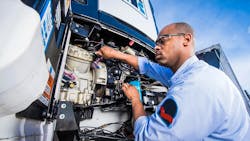Refrigerant Transition: How to keep your TRU fleet up to speed
For approximately a decade, the automotive market has been transitioning from use of its legacy refrigerant, R-134a, to the zero ozone depletion potential (ODP), lower global warming potential (GWP) R-1234yf. In fact, it’s estimated that 95% of light-duty vehicles manufactured for sale in the U.S. and 95 million light-duty vehicles on U.S. roads use this hydrofluoroolefin (HFO) refrigerant for comfort cooling. With the light-duty segment paving the way, the heavy-duty segment has a significant head start for the refrigerant transition on its horizon. From familiarizing original equipment and component part manufacturers with R-1234yf to providing comprehensive education about its use, benefits, and differences from R-134a, the light-duty segment has “pressure tested” the new fluid for heavy duty and is helping to enable a smooth transition.
This transition has already started for heavy duty, making it essential that fleet maintenance and manager professionals prepare to service R-1234yf-charged systems and start to consider bringing more of these trucks into their fleet. To plan for a successful transition, it will be helpful to understand the dynamics driving the change, familiarize yourself with the new fluid, and know the requirements for maintaining R-1234y systems in your fleet.
Refrigerant trends and what’s fueling them
Global and domestic regulations targeting R-134a and other high-GWP HFCs are the key drivers of our current transition to R-1234yf. In 2006, the Mobile Air Conditioning (MAC) Directive in Europe enforced the use of refrigerants with a GWP of less than 150. Between March 2011 and May 2022, the U.S. EPA’s Significant New Alternatives Policy (SNAP) program listed R-1234yf as “acceptable subject to use conditions” for newly manufactured passenger cars, light-duty trucks, medium-duty passenger vehicles, heavy-duty pickup trucks, complete heavy-duty vans, and nonroad vehicles. The U.S. market also is impacted by the 2020 American Innovation and Manufacturing (AIM) Act implementing an aggressive schedule to phase down HFCs by 85% by 2036.
The AIM Act stands to significantly influence the heavy-duty segment by phasing down the industry’s predominant refrigerant for comfort cooling, R-134a. The refrigerant industry took its first stepdown—a 10% reduction from the baseline in HFC production and consumption—in 2022. The Jan. 1, 2024, stepdown will reduce allocations to 40% below the baseline. The industry will step down to 60% below the baseline in 2028. These reductions in HFC allocations will naturally impact R-14a availability and the market may experience some volatility.
Here are some of the trends being fueled by these dynamics:
- We could see price volatility and continued waning availability of R-134a.
- Decreasing availability of R-134a will make it more attractive for heavy-duty OEMs to convert to R-1234yf equipment.
- In terms of availability for maintenance in the heavy-duty sector, the increasing number of light-duty vehicles transitioning to R-1234yf will free up a supply of R-134a.
- Phasedowns of HFCs will continue to increase R-1234yf demand, production, and availability.
- The “business of sustainability” will continue to increase adoption of R-1234yf as companies experience the benefits—in terms of attracting and retaining customers and staff—of integrating environmentally responsible practices into their business model.
Assessing and planning for your fleet
Fleets today consist of R-134a and R-1234yf vehicles. As R-134a trucks approach end-of-life, it’s important to know that there currently is no EPA-approved product for retrofitting to R-1234yf. Keep an eye on market pricing and refrigerant availability and balance this against the age of your equipment, cash flow available for replacing older trucks with R-1234yf equipment, and your sustainability goals. Lastly, remember the phasedown is taking place over a span of 16 years and should be managed in a way that strategically supports your business.
Repair and maintenance with R-1234yf
There’s always a learning curve with new technology. However, for heavy-duty, several factors should allow for an easier transition to repairing and maintaining R-1234yf fleets. Lean into the insights and experiences of the light-duty segment as well as industry organizations that support training. Light-duty aftermarket technicians have been working with R-1234yf since 2013, and OEMs and component manufacturers are familiar with compatibility requirements. These things will facilitate a smooth transition to R-1234yf for heavy-duty.
Another benefit for fleet maintenance professionals is that the new systems are designed specifically for R-1234yf. The biggest difference between the two refrigerants is that R-1234yf is classified as a mildly flammable A2L. Technicians should be properly trained in the safe handling of R-1234yf. Also, be aware that it’s illegal to mix the two. To prevent this, R-1234yf equipment uses left-hand threads—the opposite of R-134a. Since the heavy-duty segment will remain dependent on R-134a in some capacity while R-1234yf increasingly enters the mix, it’s advisable that shops have two R/R/R machines so they can service both.
Slow and steady wins the race
The heavy-duty industry has enjoyed a long and stable ride with R-134a. For a segment strongly focused on cost-per-mile and cost of operation, even slight volatility with the phasedown of R-134a could raise concern. However, the transition to R-1234yf is designed to allow the industry to “walk not run.”
Chemours, one of the largest manufacturers of R-1234yf (Chemours Opteon YF), is seeing this begin to work effectively with customers. By staying updated on market availability and paying attention to regulations affecting your fleet, your businesses will be able to employ a strategy that will allow for a smooth transition to R-1234yf and support the phasedown of HFC refrigerants.
Christina Spalding is the senior accounts manager for refrigerants at The Chemours Company. This article originally appeared on FleetMaintenance.com.
About the Author

Christina Spalding
Senior Account Manager, Refrigerants
Christina Spalding is the national accounts manager at Chemours. She has more than 25 years of experience in the refrigerants industry. She has gained expertise in both Stationary and Mobile refrigeration applications.
